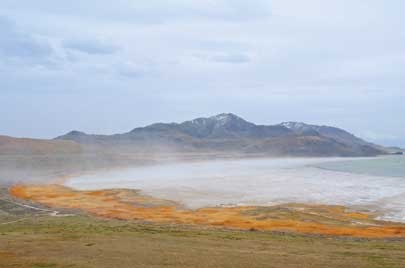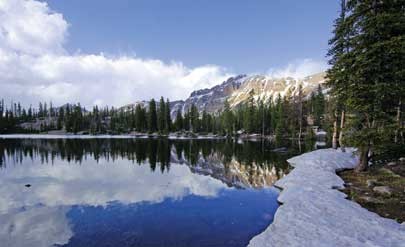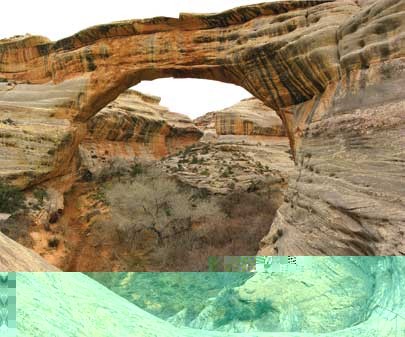
From the breathtaking mountains of northern Utah to the red-rock canyons of the south, Utah is home to some of the most diverse scenery on the planet. With so many unique places to choose from, the state is a camper’s paradise. It can be daunting to decide what backdrop you want to blend in with for your camping trip. To make the task less overwhelming, we have come up with five distinct locations for a sampling of the state’s best scenery.
Saltwater Beaches: Antelope Island State Park
Only about 40 minutes away from the hustle and bustle of Salt Lake City lies an island, where birds fly over indigo water and wildlife roams free over sandy beaches. Located on the largest saltwater lake in the Western Hemisphere and home to one of the most sizable American bison populations still in existence, this island has a lot to brag about.
Antelope Island offers a Western spin on the “island” concept—you won’t find palm trees, surfboards or drinks served with umbrellas, but this unique area offers many other attractions to the outdoor adventurer.
Grab a pair of binoculars and start your day watching the animals that call this island home, including bighorn sheep, mule deer, coyotes, bobcats and a variety of waterfowl. Next, go for a hike on one of the many trails or enjoy a bracing bike ride on the White Rock Bay Loop. If the day is warm, go for a dip in the Great Salt Lake. Even the worst swimmers will find that the extremely salty water (about five times saltier than ocean water) helps them float. When your stomach starts to grumble, take a picnic to the beach or grab a bite at the Island Buffalo Grill. For a change of pace, visit the Fielding Garr Ranch, the longest-operated homestead in the state, and get a taste of Utah’s history. As the day comes to a close, look to the west and bask in the glory of a beautiful Utah sunset reflected on the Great Salt Lake.
4528 W. 1700 South, Syracuse, 801-773-2941, day visit: $9; camping: $13, StateParks.Utah.gov

- BY ED YOURDON
- ANTELOPE ISLAND STATE PARK
Rugged Red Rocks: Goblin Valley State Park
Visiting Goblin Valley State Park is like traveling to another planet. The geological formations that make this location unique, called “hoodoos,” have an unusual, almost humanoid form and are unlike anything you’ve ever seen. Other structures, such as arches and even the occasional cave, have also been carved out by wind and water. Unlike some national and state parks, Goblin Valley doesn’t have restrictions against going off-trail, so feel free to explore. Kids love climbing on the hoodoos, and the Valley of the Goblins is the perfect place for an incredible game of hide & seek. Be sure to bring your camera to capture the shapes and shadows created by these sandstone sculptures.
The campground at Goblin Valley is a great home base. Creature comforts include picnic tables, barbecue grills, potable water and hot showers. There are even two yurts available for reservation. If possible, spend a night at Goblin Valley during the full moon to enjoy the surreal experience of exploring the park at night.
The park is relatively small, with only three marked trails, but you’re close to the San Rafael Swell, an attraction in itself. A hidden central Utah gem, the swell offers solitude and adventure. One of the most popular hikes in the swell, Little Wild Horse Canyon, is located just seven miles from Goblin Valley.
Green River, 435-275-4584, day visit: $7 per car; camping: $16 per night, StateParks.Utah.gov
Mountain Pines:
Butterfly Lake
Imagine a perfect (almost cliché) camping scene: a crystalline lake, a few fishermen whiling away the day on a rowboat, children chasing butterflies through meadows bursting with wildflowers, the smell of pine in the air and majestic mountains all around. There are few places where one can actually find all of this, and Butterfly Lake is one of them.
The lake is one of over a thousand in the beautiful Uinta Mountains, the highest mountain range in the state, and is a gateway to an immense, untouched wilderness area. The drive to Butterfly Lake alone is well worth the trip, which is reached via the Mirror Lake Scenic Byway. Once there, visitors have their pick of 20 campsites surrounded by soaring pine trees. The lake has several species of trout, so you can fish from the comfort of your home away from home.
Horse owners will feel especially welcome at this campground, as there is a separate camping loop for equestrian campers and many trails for riding. The High Uinta Wilderness is also a prime locale for hiking, whether you prefer an easy stroll or an all-day march. Just across the road from the campground is the Highline Trail, a whopping 60-mile trek across the crest of the High Uintas. A sample of this trail may be enjoyed as a day hike or, for the very ambitious, can be traversed in its entirety over the course of a week. With an entire wilderness as your backyard, Butterfly Lake won’t disappoint.
34 miles east of Kamas on Mirror Lake Scenic Byway (UT-150), day visit: $6 per car; camping: $16 per night, PublicLands.org

- BY JOE TORDIFF
- BUTTERFLY LAKE
River Adventure: Colorado River (Moab Area)
The mighty Colorado River flows through seven states and is one of the most important waterways in the United States. The Utah section of the river is incredibly scenic and offers many opportunities for outdoor recreation. There are 10 BLM-run campgrounds along the river, which are all accessed via Highway 128. Big Bend, Goose Island and Dewey Bridge all feature sites by the river with spectacular views of the surrounding red rock canyon. From any one of these campgrounds, you are only minutes away from an incredible number of outdoor experiences.
The funky town of Moab is a mere three miles away from the junction of Highway 128 and Highway 191. Moab is a fun place to relax between explorations, with great restaurants, breweries, coffee shops and other perks of civilization.
River rafting is one of the most popular activities in this area. There are white-water trips for every experience level, from the family-friendly Fisher Towers section of the Colorado River to the more intense rapids of Cataract Canyon and Westwater Canyon. For those who don’t want to get wet, there are a half-dozen hikes right off the Colorado River as well as several mountain-biking trails.
Here you can explore two great national parks and a state park: Arches, Canyonlands and Dead Horse Point are all within a short drive.
The Moab section of the Colorado River isn’t popular by accident. The sheer number of things to do there simply cannot be beaten.
Moab
Desert Soul: Natural Bridges National Monument
Natural Bridges National Monument, Utah’s oldest national monument, is located northwest of the Four Corners area where Utah, Arizona, New Mexico and Colorado meet. The monument features three elegantly carved structures framing the desert. Inside the park is a scenic loop drive that gives visitors a view of each of the bridges. For a closer look, there are short trails to the base of each bridge as well as a loop trail through White Canyon and a hike to Horsecollar Ruin. There is a 13-site campground located within the park.
One of the benefits of camping at Natural Bridges is its proximity to one of Utah’s greatest anthropological treasures. About 40 minutes from the monument lies the Grand Gulch Primitive Area, a rugged region of the Cedar Mesa Plateau once inhabited by the Ancestral Pueblo People, sometimes called the Anasazi tribe. There are many remnants of their existence, making this a popular attraction for tourists and archaeologists. Visitors can expect to come across pottery, prehistoric structures, rock art and other artifacts. In order to preserve these treasures, permits are required for hiking and backpacking.
Turkey Pen Ruins is one the of the most fascinating ruins in the area and offers an opportunity to see perfectly preserved handprints, pictographs, dwellings and an actual ancient “turkey pen.” The ruins can be reached via Kane Gulch Trail, which is a trailhead for the 51.7 mile Grand Gulch Primitive Area Trail. Don’t miss this chance to experience Utah’s past in an exciting, interactive way.
San Juan, 435-692-1234, day visit: $6 per car; camping: $10 per night, NPS.gov/NABR

- BY ALEX DERR
- NATIONAL BRIDGES NATIONAL MONUMENT